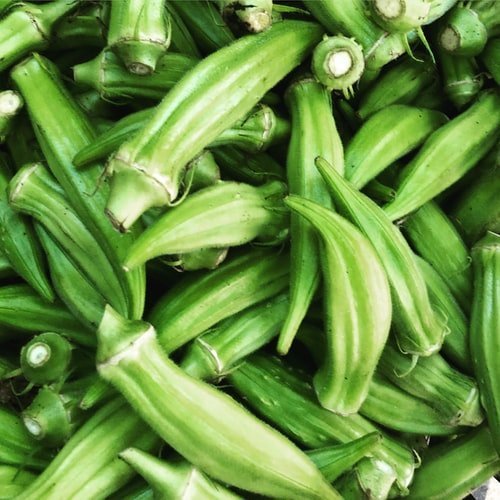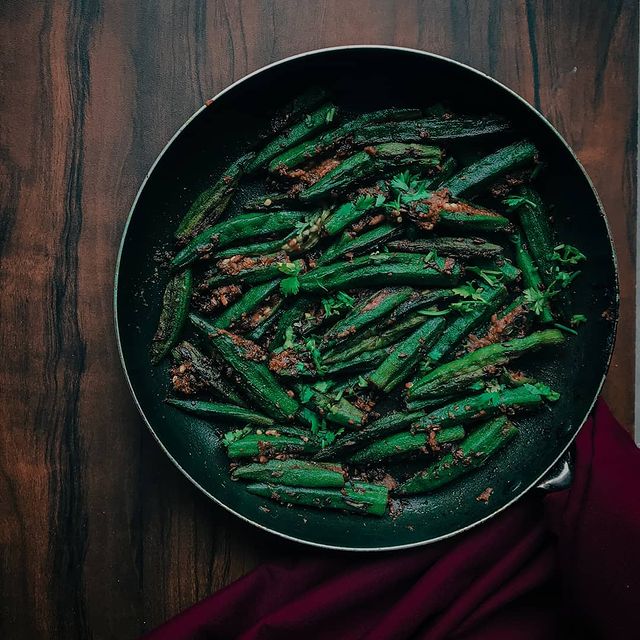
Okra has a bad reputation due to its slimy texture when cut or cooked, but it is packed with nutrients like antioxidants and fiber. With the right techniques, okra can be tasty and goo-free. Learn about okra’s health benefits, nutrition, and how to eat it.
What Is Okra?
Okra, though commonly prepared as a vegetable (boiled, roasted, or fried), is actually an African fruit. It thrives in hot, humid climates, including the southern US, where it “ends up in a lot of southern dishes,” says Andrea Mathis, M.A., R.D.N., L.D., founder of Beautiful Eats & Things. Okra pods (including stems and seeds) are edible. If you have a whole okra plant (like in a garden), you can eat the leaves, flowers, and flower buds as greens.
Nutritional Value of Okra
According to a Molecules article, okra is loaded with vitamins and minerals like vitamin C, riboflavin, folic acid, calcium, and potassium. When okra is cut and cooked, it releases a thick, slimy liquid. According to Grace Clark-Hibbs, M.D.A., R.D.N., founder of Nutrition with Grace, the goo is high in fiber. Okra’s nutritional benefits include digestive support, blood sugar management, and heart health.
According to the USDA, 1 cup (160 grams) of cooked okra contains the following nutrients:
- 56 calories
- 13 grams carbohydrate
- 3 grams protein
- 5 grams fiber
- < 1 gram fat
- 3 grams sugar

Health Benefits of Okra
If okra’s nutrient profile isn’t enough to entice you, its health benefits may be. Find out what experts say this green superfood can do for your body.
Prevents Disease
Okra is a great source of antioxidants. In okra, the main anti-oxidants are polyphenols. That makes okra one of the best antioxidant foods you can eat, thanks to polyphenols like catechin and vitamins A and C. According to Mathis, antioxidants are known to neutralize or remove free radicals (aka unstable molecules) that can damage cells and promote illnesses (e.g., cancer).
Contributes to a Healthy Digestion
If going to the bathroom is a chore, okra may be the answer. “Okra mucilage is high in soluble fiber,” says Clark-Hibbs. To help prevent diarrhea, this type of fiber absorbs water in the digestive tract to form a gel-like substance. Both the “walls” and seeds of okra contain insoluble fiber, says Susan Greeley, a registered dietitian nutritionist and chef instructor at ICE. According to the Mayo Clinic, insoluble fiber increases feces bulk and promotes intestinal muscle movement, easing constipation.
Controls Blood Sugar
Soluble fiber in okra can help prevent blood sugar spikes by forming a gel-like substance in the gut, says Clark-Hibbs. A 2016 study found that soluble fiber can help people with type 2 diabetes control their blood sugar levels. “Okra is also high in magnesium, which aids in insulin secretion,” says Charmaine Jones, M.S., R.D.N., L.D.N., founder of Food Jonezi. According to a 2019 article, magnesium helps regulate insulin levels, which in turn helps normalize blood sugar levels.
Also, supercharged antioxidants may help. Type 2 diabetes is caused by oxidative stress (an excess of free radicals in the body). A 2018 study found that eating a lot of antioxidants (like vitamins A and C in okra) can help reduce the risk of oxidative stress.
Heart-Safety
According to Clark-Hibbs, okra’s fiber helps lower LDL (“bad”) cholesterol by “collecting extra cholesterol molecules as they move through the digestive system.” Mathis notes that fiber excretes cholesterol with it. This reduces cholesterol absorption into the blood, lowering cholesterol levels and lowering heart disease risk.
Antioxidants like okra’s phenolic compounds (catechins) protect the heart by neutralizing free radicals. So here it is: According to a 2021 article, free radicals interact with LDL cholesterol, changing its physical and chemical properties. Atherosclerosis, or plaque buildup in the arteries, is caused by LDL oxidation. A 2019 scientific review notes that phenolic compounds can protect the heart by preventing LDL oxidation.
Assists in Pregnant Health
Jones says okra is high in folate, which is required to form red blood cells and support healthy cell growth and function. But it’s vital for proper fetal development (and thus found in prenatal vitamins). A fetus born with neural tube defects, or defects in the brain (anencephaly) and spinal cord (spina bifida), suffers from low folate intake during pregnancy, she explains. The National Institutes of Health recommends 400 micrograms of folate per day for adults and 600 micrograms per day for pregnant women. The USDA estimates that one cup of cooked okra contains 88 micrograms of folate.
Okra’s Potential Risks
Kidney stones prone? Okra is high in oxalates, which increase the risk of kidney stones if you’ve had them before, says Clark-Hibbs. Extra oxalates can mix with calcium to form calcium oxalates, which is the main component of kidney stones. Oxalates are excreted via the urine (which travels through the kidneys) and may increase the risk of kidney stones, according to a 2018 review. Those “prone to kidney stones” should limit their intake of oxalate-rich foods, she advises.
Mathis advises caution if you’re on anticoagulants (blood thinners) to prevent blood clots. Okra is high in vitamin K, a nutrient that helps blood clot, a process that blood thinners prevent. Blutthinners help patients with conditions like atherosclerosis avoid blood clots, lowering their risk of heart attack or stroke. Increasing your intake of vitamin K-rich foods (like okra) can cause blood thinners to stop working, says Mathis.
If you’re prone to stones or taking a blood thinner, ask your doctor how much okra you can safely eat.
Okra Cooking Instructions
“Okra comes fresh, frozen, canned, pickled, and powdered,” Jones says. Buy It: $10 for two bags (amazon.com) sells dried okra snacks. It comes frozen, breaded, or packaged in pre-made meals. Although non-breaded options are healthier because they contain more nutrients and no added preservatives like sodium, Jones says.
Okra powder? It’s more of a seasoning than a vegetable replacement. A healthier alternative to salt or pickled ingredients, Jones says, but it’s unlikely to be found at your local Whole Foods. You can find products like Naturevibe Botanicals Okra Powder at a specialty store or, not surprisingly, on Amazon.
Fresh okra should be firm and bright green, not discolored or limp, advises the University of Nebraska-Lincoln. Refrigerate unwashed okra in a sealed container or plastic bag. The University of Arkansas warns that fresh okra is perishable and should be eaten within two to three days.
While okra can be eaten raw, most people cook it first to remove the skin’s prickly texture. Okra can be grilled, roasted, or fried. However, cutting or cooking okra releases the slimy mucilage that many dislike.
To avoid slime, cut the okra into larger pieces. “The less you cut it, the less slimy it becomes,” says Clark-Hibbs. Jones advises against using moist cooking methods (e.g. steaming or boiling), which add moisture to the okra and thus enhance the goo. Clark-Hibbs explains that dry cooking reduces the amount of slime released by the okra because it cooks faster and at a higher temperature. “Acidic ingredients such as tomato sauce, lemon, [or] garlic sauce,” Jones says, can reduce slime. Get out!
Ready to try okra? Here are some tasty okra recipes from experts:
As a roasted dish – The easiest and most delicious way to prepare okra is to roast it, says Clark-Hibbs. “Lay the okra in a single layer on a cookie sheet, drizzle with olive oil, and season with salt and pepper to taste. This will soften the okra without making it slimy. “
As a sauteed dish – Sauté okra with your favorite spices. 1st, “preheat oil in a large pan on high heat.” Add okra and cook for 4–5 minutes until bright green. Before serving, season with salt and pepper, “Matthews. Don’t know where to start? Try this recipe for crispy Indian okra from My Heart Beets.
In stir-fry – Stir-fry Add okra to your next weeknight stir-fry. The dish requires a quick cooking method to reduce slime. Try this easy 4-ingredient okra stir-fry from Omnivore’s Cookbook.
In stews and soups – Soups and stews Okra’s mucilage can work in your favor if used properly. Mathis says it can thicken dishes like cornstarch (stew, gumbo, soup). “Just add diced okra to your soup 10 minutes before it’s done,” she says. Try this delicious seafood gumbo recipe from Grandbaby Cakes.
In a salad – Combine okra with other summer vegetables to maximize summer produce. To make a delicious summer tomato and corn salad, Greeley suggests cutting up cooked okra.

